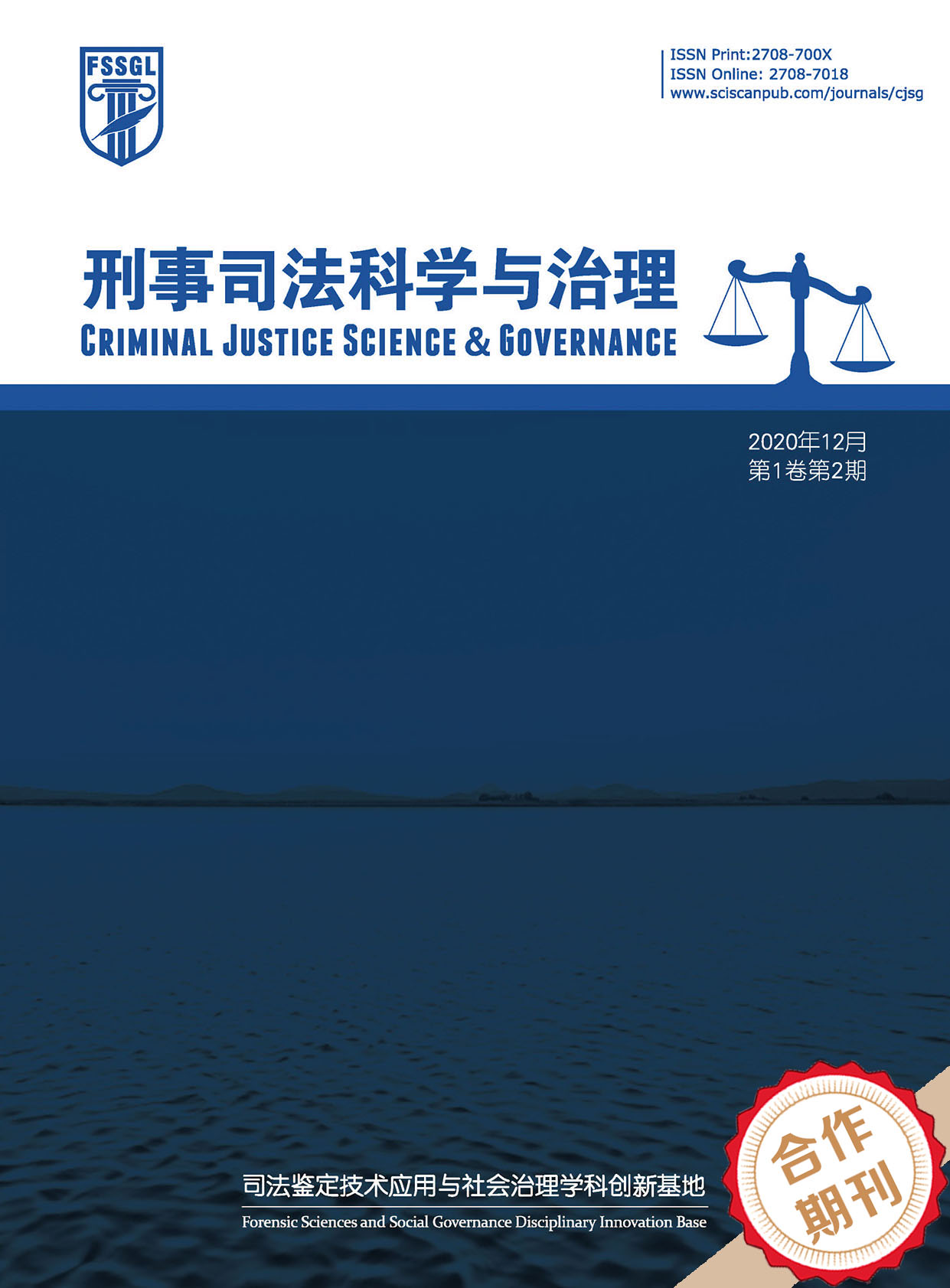Criminal Justice Science & Governance
刑事诉讼涉案财物保管机构的模式评析
Modes of Custody Institutions Involved in Criminal Procedure
- Authors: 谭秀云
-
Information:
西北政法大学公安学院,西安
-
Keywords:
Property involved in crime; Custody institution; Centralized custody; Third-party escrow刑事涉案财物; 保管机构; 集中保管; 第三方代管
- Abstract: The custody institutions involved in criminal procedure have four modes: “department custody mode”, “centralized custody within the department mode”, “centralized custody across departments mode”, “the combination between centralized custody across departments and the third- party escrow mode”. The department custody mode has many circulation links, large custody risks and many custody subjects. The centralized custody within the department mode only exists in the public security organs, procuratorates and courts, and its scope of application is limited. The centralized custody across departments mode establishes centralized management center across departments, but it could not effectively take care of special properties and documents. In order to separate the case handling department from the custody department and the case handling personnel from the custody personnel, and to ensure the value and value appreciation of involved properties, China should adhere to the mode of the combination between centralized custody across departments and the third-party escrow, and set up cross-department centralized custody institutions, which are supplemented by the joint custody of third-party escrow institutions. 刑事涉案财物的保管机构有四种模式:“部门分别保管模式”“部门内部集中保管模 式”“跨部门集中保管模式”“跨部门集中保管与第三方代管相结合模式”。部门分别保管模 式的流转环节多,保管风险大,保管主体多元;部门内部集中保管模式仅在公、检、法各系统 内部集中保管,其适用范围有限;跨部门集中保管模式设立跨部门的涉案财物集中管理中心, 但它不能有效保管特殊财物、文件。为了实现办案部门与保管部门、办案人员与保管人员相分 离,确保涉案财物保值、增值的目的,我国应当坚持跨部门集中保管与第三方代管相结合模式, 设立跨部门的集中保管机构,辅之以第三方代管机构共同保管。
- DOI: https://doi.org/10.35534/cjsg.0101012
-
Cite:
谭秀云.刑事诉讼涉案财物保管机构的模式评析[J].刑事司法科学与治理,2020,1(1):154-166.
https://doi.org/10.35534/cjsg.0101012
相对于发现、扣押、固定程序而言,涉案财物的保管并没有引起理论界和实务界应有的重视,法律也缺乏对保管程序的规定。如果没有妥善的保管制度,所收集的证据容易被混淆、破坏,涉案的财物、文件无法得到妥善处理。1965年我国最高人民法院、最高人民检察院、公安部、财政部联合颁布的《关于没收和处理赃款赃物若干问题的暂行规定》对赃款赃物的保管作了一些规定,但是规定的内容已经不适宜社会的发展需要。2012年《刑事诉讼法》第234条规定,公、检、法应当妥善保管扣押的财物及其孳息,任何单位和个人不得挪用或自行处理。2018年《刑事诉讼法》第245条第1款未作改变。《公安机关办理刑事案件程序规定》(以下简称《公安规定》)第230条规定,公安机关应当妥善保管扣押的财物及其孳息、文件,不得使用、调换、损毁或者自行处理。十八届三中、四中全会明确提出要求,规范涉案财物的司法程序,2015年中央全面深化改革领导小组出台《关于进一步规范刑事诉讼涉案财物处置工作的意见》,提出建立办案部门与保管部门、办案人员与保管人员相分离的制度。随后,最高人民检察院出台了《人民检察院刑事诉讼涉案财物管理规定》、公安部也颁布了《公安机关涉案财物管理若干规定》,它们进一步规范了涉案财物的管理要求。
总体来看,立法层面上,我国相关法律法规对涉案财物保管的机构、场所、方法、管理、监督等规定粗疏,缺乏可操作性。实践层面上,公、检、法未妥善保管涉案财物、文件,随意使用、毁损、调换、挪用涉案财物的现象较多。理论层面上,有人在比较“实物移送、分别管理模式”“单据移送、公安管理模式”的基础上,提出设立“单据移送、三家共管”的涉案财物管理制度构想[1]。有人提出建立涉案财物的“跨部门”管理机制,理顺涉案财物的移送、管理、处置流程[2]。也有人在此基础上提出,设立一个独立统一的涉案财物管理中心,由无利害关系的第三方负责涉案财物的登记、交接、保管工作[3]。还有人检视了刑事诉讼涉案财物处置程序正当性问题的原则,并主张通过建立跨部门的涉案财物信息管理平台、细化涉案财物分类和引入社会托管。然而,这些对刑事诉讼涉案财物保管机构的探讨,缺乏对我国司法实践中有益探索的经验总结,富有见地和深度的著述并不多见。虽然一些论文对证据保管有所提及,但是也都在研究其他问题的过程中附带提及,对涉案财物保管机构的研究,亟待进行系统的考量和完善。本文旨在规范涉案财物的保管机构,通过梳理我国涉案财物保管机构的四种模式,提出完善我国涉案财物保管机构的具体思路。
1 涉案财物部门分别保管模式
侦查阶段、审查起诉阶段和审判阶段由公、检、法分别管理涉案财物,是我国现行的涉案财物管理模式。根据《最高人民法院关于适用<中华人民共和国刑事诉讼法>的解释》第359条第1款的规定,法院、检察院应当保管扣押的财物、文件。《公安规定》第230条第1款规定,公安机关应当妥善保管财物及其孳息、文件。公、检、法分别有权设立专门的保管场所和设施,并指定专门的保管人员。除了鲜活易腐物品、不宜移送的财物(不动产、车辆、船舶、航空器等)、违禁品之外,公安机关应当将扣押的财物、文件移送到检察机关,检察机关提起公诉的,应当将涉案财物随案卷移送到法院。
部门分别管理模式主要具备两大优势:一是有利于公、检、法三机关明确各自的责任,确保涉案财物保管的独立性。二是有利于案件承办人开展审查工作,及时解除与案件无关的涉案财物,积极组织审查、移送鉴定、庭审质证。然而,部门分别保管模式也有其弊端:
第一,流转环节多,保管风险大。财物、文件被扣押之后,要经历入库、保管、出库、移送、调用等环节,涉及到侦查人员、检察官、法官、保管人、鉴定人、拍卖人等多种人员。涉案财物在任何一个环节、任何一种人员手中,都可能发生被挪用、调换、破坏的可能。有些基层的公、检、法缺乏专门的保管场所,或者很多保管人员不具备专门的保管能力,不能按照保管的要求进行规范操作,露天堆放涉案财物,从而发生涉案财物被损坏、污染、调换、丢失等现象,难以发挥实物证据证明案件真实性的作用。2018年3月15日至3月30日笔者到S省X市进行了调研,分别访谈了C区公安分局和X区公安分局刑警大队的干警;C区检察院公诉科的检察官;C区法院和G区法院的刑庭法官。据他们介绍,公安局及其辖区的派出所里没有专门的保管场所和保管人员,扣押的财物、文件一般由办案人员自行保管、自行负责;检察院和法院各自都配备了一间保管室和一名保管人员,但是保管室里面仅仅摆放了几个柜子,只能存放一些手机、银行卡、钥匙等小件物品。根据他们共同的反映,公、检、法缺乏资金去建立专门的保管场所,用于存放一些体积较大的涉案财物。对于大件的涉案财物(如汽车、摩托车、麻将机等)都是找了民间的一个专门场地,保管场地也缺乏遮阳、防雨、防火、防盗等必要的防护设施,所以办案人员自己也非常担心涉案财物出现问题后,相关权利人追究他们的责任。
第二,保管主体多元,司法成本大。部门分别保管的模式要求公、检、法各自投入大量的人力、物力和财力,配备相关的保管场所和保管人员;分别建立涉案财物管理台账,每个月、每个季度、每年都要清点相关财物、文件,整个工作都要耗费大量的司法成本。公、检、法各自在不同诉讼阶段保管涉案财物,也带来了保管主体分散、缺乏统一的保管标准、保管行为不精细、操作不规范、衔接不畅等问题。由于涉案财物的保管链条要经过几个环节,到底是哪个部门没有妥善保管涉案财物,有时导致公、检、法之间相互扯皮,相互推卸责任,致使权责不清。
第三,保管混乱,监督缺乏力度。目前,办案部门与保管部门尚未分离,涉案财物保管混乱,无法实现科学化、类别化管理。扣押涉案财物后办案人员是否及时办理入库保管手续、涉案财物的保管状态、涉案财物是否与案件有关等信息,只有办案人员清楚,纪检监察部门无法进行有效监督,当事人及其近亲属、辩护人也无法获得涉案财物的保管情况。缺乏有效的监督,造成与案件无关的财物得不到及时解除;对决定撤销、不起诉或无罪判决的案件,涉案的财物不能被及时返还。
2 涉案财物部门内部集中保管模式
为了解决涉案财物的保管难题,各地的司法机关先后进行了有益探索,部门内部集中保管模式就是结晶之一。部门内部集中保管模式是指,公、检、法分别在各自系统内,两个或两个以上的同级办案部门建立统一的保管场所,并由其中的一个部门对涉案财物进行统一管理的模式。
江苏省如皋市公安局从2004年就开始探索涉案财物管理制度,到2010年该局已成为全国公安执法规范化的典型。涉案财物管理中心保管的是公安局各办案单位的大件涉案财物。该局采用条形码识别、财物集中存放、信息系统跟踪管理[12]。上海市公安局从2010年开始实现“扣管分离”,公安机关各办案单位制定了一系列规章制度,开发了“网上办案平台”涉案财物管理系统,着力解决涉案财物在移交、借用、归还、保管、处理中的难题。从2010年8月到2011年5月,该系统已录入信息71130条,关联案件19706起[13]。福建省漳州市公安局龙文分局在2010年成立了涉案财物管理中心,探索出了“龙文模式”。该涉案财物管理中心集中保管辖区内的涉案财物,开发了龙文分局涉案财物管理系统,形成一级仓库与二级仓库、“实物仓库”与“虚拟仓库”的有效对接。2010年北京市的东城区、西城区、崇文区、宣武区检察院已经完成了扣押款不动、单走单据、网上办公、共管试点工作[14]。
部门内部集中管理模式的优势在于:一是节约司法资源。涉案财物的移送和保管向规范化、集约化和信息化的方向转变,其有助于降低司法成本,减少设置保管场所与保管人员的数量和经费开支。二是降低保管风险。在涉案财物被集中统一保管后,保管人员对收到的财物、文件建账设卡,实行一案一卡、一物一卡(码)。对于细小物品,还需要对物品种类进行分袋、分件、分箱、设卡和保管。对于入库、出库、归还的,需要检查涉案财物,确保账实相符,并制作相应清单,避免涉案财物在保管过程中被污染、调换、毁损、灭失等。然而,部门内部保管集中模式仅仅解决的是公、检、法各系统内部涉案财物的保管,它的适用范围存有局限,未建立公、检、法三机关之间关于涉案财物的移送、保管、调用、处理的合作平台。
3 涉案财物跨部门集中保管模式
跨部门集中保管模式是指,公、检、法三机关建立集中的涉案财物管理中心,扣押的财物、文件全部移送至涉案财物管理中心集中保管,各部门保管各自诉讼阶段的涉案财物,涉案财物的移送、保管、调用、对接的法律手续通过网上流转,不移送实物的保管模式。在同一辖区内,撤销公、检、法三机关各自设立的涉案财物的保管和处理部门,成立一个新的涉案财物共管中心,管理中心会给每个涉案财物贴条形码,利用网络技术管理。办案机关根据公、检、法统一制定的管理制度,采用单据移送的方式,只移送扣押清单和书面材料,不再移送扣押的实物,几分钟之内便可完成数页清单的移送,极大地提高了涉案财物保管、移送的质量和效率。
为了破解涉案财物管理混乱的“难题”,全国多省、市积极地探索这种集中、高效、独立的涉案财物管理中心。2015年浙江省诸暨市成立了浙江省第一家公、检、法一体的涉案财物管理中心,该中心设在公安机关内[15]。2015年7月成都市温江区建成了四川省首个跨部门的刑事诉讼涉案财物集中管理中心。公、检、法的涉案财物统一存放在该中心,中心的场所设在温江区公安分局内,并由公安分局代为保管[16]。2017年北京市通州区在公安分局内成立了跨部门的涉案财物管理中心,对同级公、检、法的涉案财物进行跨部门统一管理[17]。江苏省淮安市公安局洪泽分局自主研发了江苏省首个“警银通”涉案财物管理平台,初步实现了公安保管,打通了公、检、法一体化涉案财物管理的目标[18]。山东聊城推行公、检、法一体化的涉案财物管理模式,并在公安局内部设立了涉案财物管理中心,公、检、法各自派1~2名保管人员,负责本部门涉案财物的保管、移送、对接、文书的网上流转、查验、催收、审核等工作[19]。
试点的运行效果良好,引起了社会的高度关注。从2015年年底到2016年8月份,成都市集中的涉案财物管理中心收到的案件有9500余件,涉案财物的保管信息有3万余条;公、检、法三家共享案件有1700多件,涉案财物保管信息有6300多条。山东聊城的涉案财物管理中心自运行以来,收到涉案财物270件、物证1200件。在该中心设有9类物证保管室,涉案财物受理区、异形物品区、车辆停放区各1个。2015年在河北省政法委的领导下,邢台市建立了跨部门的涉案财物集中管理中心,实现了一码全程跟踪、一网多维监督、一键及时展示、一地集中保管。截止到2017年4月,该中心已录入涉案财物20046件、涉案款达到3300余万元,管理中的纠正违法错误率从11%降至2%[20]。各地的做法为探索跨部门集中保管模式的推行,积累了宝贵的经验:
第一,加大了涉案财物保管的投入力度。涉案财物集中管理中心明确了功能区分,配备了相关设备,将信息化、自动化技术引入中心建设规划中。成都市温江区提出了“大集中、小分散”的思路,涉案财物集中保管场所采取了“1+3+2”模式,即1个涉案财物集中管理中心、3个功能分中心、2个保管点(a)。涉案财物不随案移送,扣押清单、相关证明材料、法律文书等通过网上流转,减少了涉案财物出库、装卸运输、清点入库的环节,提高了司法效率。四川省峨眉市建有“1+3”模式,其管理模式与温江区的大同小异。它在涉案财物集中管理中心还设有受理区、监控区和保管区,占地575平方米[21]。江苏省淮安市洪泽公安分局建有600多平方米的涉案财物管理中心,设有大件物品库、常规物品库和资金专管库,并配备了保险箱、消磁柜、通风机、储物架等必要设施[18]。在规范化的管理中,还运用RFID智能管理系统、射频智能柜、智能计算、智能盘库、自动报警等高科技技术。
第二,建立了涉案财物的“电子身份证”。通过二维码技术,保管部门给涉案财物建立了“电子身份证”,实行“一案一档”“一物一码”。条码中存有涉案财物的具体信息,包括:案由、涉案财物的来源、涉案财物的特征、存储位置等。在入库、保管、出库的过程中,通过扫码达到方便、快捷、准确的目的。2015年8月河北省临城县检察院开始运用二维码信息管控技术,还起草了《关于实行涉案财物二维码统一管理的规定(试行)》,实现了物码相符、码随案走、网上流转。从侦查、起诉、审判到执行,全程一码,精确管控[22]。
第三,设立了涉案财物的集中管理信息平台。通过建立信息共享平台,公、检、法对涉案财物、文件的登记、入库、保管、出库、移送、返还、没收等,全部实现网上登记、管理和监督。加强信息化管理,实现公、检、法之间的信息共享,完成涉案财物管理的信息对接。成都市温江区的涉案财物管理中心建立了“1+3”的信息共享平台。“1”指全省政法专网平台建立中转媒介,“3”指公、检、法各自办案系统中涉案财物管理模块。通过二维码技术,公、检、法之间的信息通过政法专网平台实现数据交换[23]。信息共享平台的建立不仅便于快速查询涉案财物的基本情况、保管人与办案人等信息,还增强了对办案单位的约束力,避免在移送财物时产生的运输成本,降低了涉案财物丢失、毁损、灭失的风险。
然而,对易贬值的财物或者市场价格波动较大的股票、债券、基金份额等的保值、增值,我国公、检、法的保管场所和保管人员往往不具备这方面的能力。随着涉案财物的种类增多、数量递增、价值变大,当事人或相关权利人对涉案财物的保管要求越来越高,现行的保管模式、保管条件和保管人员已无法适应社会发展的需要。因此,为了实现涉案财物规范化管理的同时,部分特殊财物保值、增值的目的,有必要探索新的保管模式。
4 涉案财物跨部门集中保管与第三方代管相结合模式
在比较前面三种保管模式优缺点的前提下,基于提高办案效率、降低司法成本、保障证据真实性和同一性的目的,公、检、法应当设立跨部门集中保管的涉案财物管理中心。笔者主张,在涉案财物的保管程序中,坚持跨部门集中保管与第三方代管相结合模式,即设立跨部门集中保管的涉案财物管理中心,辅之以政府指定或委托的第三方代管机构保管。理由如下:
4.1 跨部门集中保管有利于实现扣押执行与扣押保管相分离
2015年《公安机关涉案财物管理若干规定》第8条第4款规定,严禁办案人员自行保管涉案财物。2015年《人民检察院刑事诉讼涉案财物管理规定》第7、10~11条确立了扣押执行与扣押保管相分离原则,实现二者分工负责、相互制约的目的,防止侦查机关存在违法保管涉案财物的行为。公、检、法应当在扣押后的3日内将涉案财物、扣押清单一并移送至涉案财物管理中心登记保管。对于特殊涉案财物的保管,由办案机关在拍照或录像后按有关规定处理,或是移送到有关主管机关(b)。对于扣押后需要及时进行检验、鉴定、辨认的涉案财物,或者异地扣押财物、文件的情形,可以不受“3日内”的期限限制,但应当在完成上述事项后及时移送到涉案财物管理中心登记保管。对于原物不便搬运或是不动产的,应当在保证侦查活动正常进行的前提下,将被查封的财物交持有人或近亲属保管,并将相关权利证书、照片移送至管理中心。对于易毁损、变质、不易保管的涉案财物,可以先拍卖、变卖,并将拍卖、变卖款移送至管理中心。总之,除法律另有规定外,侦查人员、检察官和法官都应当先将涉案财物移送至涉案财物管理中心,实现办案部门与保管部门、办案人员与保管人员相分离的目的。
4.2 跨部门集中保管有利于实现公、检、法权责分明
涉案财物保管机构的设置应当遵循保护公民财产权与制约权力的原理。合理配置公权力才能合法让渡公民的私权利。统一的跨部门涉案财物管理中心究竟由中立的第三方行政机关保管,还是由公、检、法三机关共同保管呢?统一的跨部门涉案财物管理中心究竟单独设立,还是依附于公安机关设立呢?从长远的角度看,统一规范、中立高效的改革规划,要求建立中立于公、检、法等专门的跨部门保管机构,由政府公务仓代为保管的观点[4],固然能较为彻底地从侦查权、公诉权和审判权中剥离涉案财物的保管权,完全由公、检、法之外的第三方机构保管,能保障保管机构的独立性,但是这种观点并非契合了我国司法的实践经验,实现了节约经济成本的目的。因此,笔者主张跨部门集中保管与第三方代管相结合的保管模式。由政府投资改造或新建公安机关现有场所,建立公、检、法共用的涉案财物集中管理中心,并由公安机关代管;对于部分难以建立集中涉案财物保管的地方或不便于保值、增值的涉案财物,则由符合条件的第三方机构代为保管,以实现涉案财物保管、保值、增值的目的。
首先,将跨部门涉案财物管理中心设在公安机关内部,有利于节约司法资源。跨部门涉案财物管理中心是独立于公、检、法的保管机构,其行政隶属关系不依附于公、检、法。建立跨部门的集中保管机构可以减少涉案财物在不同部门之间流转的次数,统一保管标准,公、检、法不需要在各自部门内设立保管场所,造成司法资源的浪费,避免主体多元导致涉案财物保管不当的现象。笔者主张,将跨部门集中涉案财物管理中心设在公安机关内部,是因为公安机关承担了绝大部分的侦查工作,大部分涉案财物由其收集、提取、扣押,所以公安机关保管的涉案财物的数量也比检察院和法院保管的数量多很多,将涉案财物保管中心设在公安机关内,可以便于侦查人员办案,减少移送的工作量,符合办案规律。在全国各省、市对涉案财物管理中心的积极探索中,各地积累的很多经验有个共同特点,即由公安局代为保管涉案财物,或者涉案财物集中保管中心设在公安局内部。在投入较少的情况下,若能充分利用公安机关的现有资源,尽快建立涉案财物集中保管中心,实现节约司法成本、提高司法效率的目的。
其次,由公、检、法集中共同管理涉案财物,有利于部门之间权责分明。跨部门涉案财物管理中心虽然设在公安机关内部,但是由公、检、法集中共同管理涉案财物。公、检、法各自派人员分别保管侦查阶段、审查起诉阶段和审判阶段的涉案财物。涉案财物的登记、入库、保管、出库、移送、返还等通过网络平台办理流转手续,不移送实物。不再设立单独的第三方保管机构,由公、检、法共同管理涉案财物的做法,不仅能在现行体制内优化权力配置,减少机构设置与人员编制,节约司法成本,还能统一保管标准,明确公、检、法各部门之间的权责。
最后,通过科学的管理机制化解公安机关不中立的问题。将涉案财物集中管理中心设在公安机关内,会产生公安机关不中立的担忧。涉案财物管理中心可以设置科学的管理规则,通过规范性的文件解决权力偏颇的难题。由公、检、法三机关各自派员入驻涉案财物管理中心,各自保管各阶段的涉案财物,明确涉案财物的移送、入库、出库、借用、记录等具体规则。随着涉案财物信息管理平台、涉案财物“电子身份证”的建立,涉案财物管理的内外部监督将会更加规范,不中立的问题也将得到遏制。
4.3 信息化平台为跨部门集中保管提供可能
信息化平台的建设是刑事涉案财物保管的发展趋势。随着刑事案件数量不断增多,2018年各级法院审结一审刑事案件达到了548.9万件,判处罪犯607万人[24]。因此,通过信息化平台管理涉案财物显得尤为重要。刑事涉案财物的信息化平台是依托计算机管理的平台,专门人员将刑事涉案财物的相关信息输入计算机系统,并实现涉案财物的查询、管理、短信提醒、涉案财物处理等多重目的[25]。刑事涉案财物在公、检、法之间移送、保管的过程中,往往发生移送不畅、积压严重、保管的财物污损、丢失等现象,而信息化平台专门针对这些问题,利用计算机技术,通过数字化、网络化和智能化等管理手段,利用二维码扫描、报警系统等科学技术,传递刑事涉案财物管理信息,避免实物移送带来的不便。刑事涉案财物的信息化平台建设,不仅可以提高涉案财物保管的效率,落实涉案财物的管理责任制,增强涉案财物管理的透明度,畅通涉案财物的移送渠道,还能够实现公、检、法三机关之间的信息共享,保障涉案财物的同一性和真实性,保护公民的财产权。
一方面,计算机技术的广泛运用为刑事涉案财物信息平台的建设奠定基础。电子计算机技术的应用范围已经渗透到人们的生产、生活、交流的许多领域之中,并对社会发展起到了举足轻重的作用。截至2018年6月,中国网民规模达8.02亿,互联网普及率达到57.7%,用户人数已经超过国民半数。网民规模增速有所提升,2018年新增网民2968万人,增长率为3.8%[26]。随之而来的是刑事涉案财物管理过程中引入计算机技术将成为人们关注的热点话题。自公安部颁布《公安机关涉案财物管理若干规定》以来,实务部门也都很重视涉案财物的信息化管理。早在2004年江苏省如皋市公安局开始尝试刑事涉案财物信息化管理,采用条形码管理方式,利用计算机管理登记[27]。随着计算机技术的发展,在前面提及的试点地区中,信息化平台的建设对刑事涉案财物管理的改革起到了重要的推动作用,各级部门也在积极探索涉案财物信息化管理的多种途径。
另一方面,保管人员掌握的科学技术为刑事涉案财物信息平台的建设提供条件。公、检、法中涉案财物的保管人员不仅要具有法学、管理学等方面的专业知识,还应当掌握计算机方面的基本技能。随着计算机技术的广泛普及,普通公民都已具备操作计算机的能力。在刑事涉案财物的管理过程中,保管人员多为年轻人,这为信息化平台的运行提供了人员条件。
4.4 第三方机构代管有利于实现涉案财物的保值、增值
为了便于部分涉案财物实现保值、增值的目的,笔者主张将这部分涉案财物交由政府指定或委托的第三方代管机构保管,弥补公、检、法跨部门集中保管带来的不足。在我国司法实践中,已有部分实务部门进行了有益探索。2016年四川省公安厅确立了以共建共用为主体、购买服务为补充的涉案财物保管场所建设模式。由第三方机构代管的互补形式,在实践中发挥了重要作用。
首先,公、检、法不具有对涉案财物保值、增值的职责。根据2018年《刑事诉讼法》(第3、8、10条)、《人民检察院刑事诉讼规则(试行)》第2条、《公安机关办理刑事案件程序规定》(第3条)的规定,公、检、法负有保管扣押物的职责,保管属于扣押等侦查行为的持续状态,但它们不具备对涉案财物保值的职权。2015年《关于进一步规范刑事诉讼涉案财物处置工作的意见》也未提及公安机关与检察院的办案人员与保管人员负有对涉案财物的保管职责。既然公、检、法无涉案财物保值、增值的职责,为何不将这种职责交由第三方管理?这种强化公、检、法的办案力量主要集中在侦查、起诉、审判业务的职权配置,也很契合十八届四中全会的决定和十九大报告中深化司法改革的方针。
其次,公、检、法缺乏保值、增值涉案财物的能力。我国公、检、法既无对涉案财物保值、增值的职责,又无此相关的业务技能。在司法实践中,公、检、法缺乏精通金融、管理、投资理财等知识的专门人才,经营、管理股票、债券、基金份额等易贬值财物的管理水平低下,因而涉案财物贬值的现象频发。例如,2016年9月25日成都铁路中院通过“司法拍卖”网络平台,对刘汉、刘维一案中的13辆豪车进行公开拍卖。但13辆司法拍卖车的报价引起人们的热议,其中奔驰CLK起拍价4万元、宝马X5起拍价2万元,一辆原价为370万的宾利欧陆仅使用3年半,法院起拍价已不足半价;而一辆保时捷凯宴起拍价仅为19.89万元[28]。又如,在付琦向珲春市公安局申请国家赔偿案件中,付琦的房屋被拍卖,市场价值4万元/平方米的房屋,以1.5万元/平方米的价格被拍卖掉,造成直接经济损失达1194万元[29]。
最后,相关国家和地区已在涉案财物保管中引入了其他保管机构。国际社会也很重视涉案财物的管理与处理,有些国家已经建立了财产委托人制度。财产委托人制度是一种经过权力机关授权或者委托公共托管人专门管理可变现的财产,并实现变现财产价值的制度[30]。为了加强对涉案财物的保管,提高犯罪收益的利用率,《国际刑事法院规约》中成立了信托基金制度,美国司法部设有“资产没收基金”,英国设置了“扣押资产基金”[31],对被没收财产进行管理和处理。鉴于我国的司法实践与域外的相关经验,我国应当着力建立第三方保管机构。有学者建议,有关部门授权给具有经济管理经验和职能的政府部门(如国资委),由其成立相关的基金管理组织。考虑到我国的实际情况,该学者还建议独立的第三方适宜由拍卖公司担任[32]。
基金项目
陕西省教育厅2019年专项科研计划项目“刑事扣押的客体范围研究”(项目编号:19JK0877);西北政法大学2020年校级青年项目“大数据侦查的法律属性及其规制研究”(项目编号:2020QN04);国家社科基金2014年度青年项目“审美共通感的公共哲学意义研究”(项目编号:14CZX054)。
参考文献
[1] 程建.刑事诉讼涉案财物集中管理的实证调研和制度构想[J].上海政法学院学报,2013(2):41-44.
[2] 万毅,谢天.刑事诉讼涉案财物管理机制研究——以我国C市W区的改革实践为分析样本[J].人民检察,2016(17):5.
[3] 李玉华.论独立统一涉案财物管理中心的建立[J].法制与社会发展,2016(3):70.
[4] 田力男.刑事涉案财物保管与处置新制研究[J].法学杂志,2018(8):119-122.
[5] 熊秋红.刑事诉讼涉案财物处置程序检视[J].人民检察,2015(13):31-36.
[6] 葛琳.刑事涉案财物管理制度改革[J].国家检察官学院学报,2016(6):122.
[7] 陈永生.证据保管链条制度研究[J].法学研究,2014(5):184.
[8] 杜国栋.论证据的完整性[M].北京:中国政法大学出版社,2012:72.
[9] 陈瑞华.实物证据的鉴真问题[J].法学研究,2011(5):127.
[10] 袁坦中.论刑事扣押物品的保管规则[J].求索,2008(11):146-148.
[11] 何家弘,刘晓丹.论科学证据的采纳与采信[J].中国司法鉴定,2002(1):14.
[12] 李孝文,曹钰华.让涉案财物管理更“阳光”——如皋市公安局涉案财物管理中心见闻[N].江苏法制报,2015-01-20(2).
[13] 吴艺.上海:涉案财物管理系统录入信息七万余条[N].人民公安报,2011-05-04(2).
[14] 陈旭,杨国良,李文仲.刑事诉讼中扣押款物移送处理的实务困境及制度完善[J].北京政法职业学院学报,2010(4):64-65.
[15] 陈东升,陈伯渠,王雨.首家刑事诉讼涉案财物管理中心落户诸暨[N].法制日报,2015-05-08(2).
[16] 夏修露.“集中+分散”模式 因地制宜建设保管场所——四川试点刑事诉讼涉案财物管理改革观察之场所综合篇[N].四川法制报,2016-08-10(4).
[17] 汤瑜.北京:多举措规范涉案财物管理 破解移送,处置难题[N].民主与法制时报,2017-11-23(3).
[18] 赵家新,徐国庆,任礼明.淮安洪泽:“警银通”规范管理涉案财物[N].人民公安报,2017-07-04(3).
[19] 王金梅,付延涛.聊城:推行公检法一体化涉案财物管理[N].人民公安报,2017-11-14(6).
[20] 马竞,周宵鹏.涉案财物——“码”到底案结物清[N].法制日报,2017-04-08(2).
[21] 林辉,张建华.峨眉山市涉案财物管理出成效[N].四川法制报,2017-05-24(12).
[22] 耿建扩.河北临城:刑事涉案财物实现统一管理[N].光明日报,2016-12-15(7).
[23] 王自然,胡雪.成都:建立管理中心规范涉案财物管理[N].人民公安报,2016-07-25(3).
[24] 新华网.最高人民法院工作报告(全文)[EB/OL].[2019-01-20].http://www.court.gov.cn/zixun-xiangqing-87832.html.
[25] 孙明泽.刑事涉案财物的信息化管理[J].重庆邮电大学学报(社会科学版),2018(2):58.
[26] 中国网信网.第42次《中国互联网络发展状况统计报》[J/OL].[2019-01-20].http://www.cac.gov.cn/2018-08/20/c_1123296882.
[27] 人民公安报.江苏如皋公安局:信息化管理涉案财物[J/OL].[2019-01-20].http://www.chinapeace.gov.cn/2015-01/19/content_11170040.htm.
[28] 法制日报.拍卖刘汉13辆豪车是如何定价的?[J/OL].[2018-07-06].http://news.163.com/16/0923/10/C1L11BPH00014Q4P.html.
[29] 付琦申请珲春市公安局刑事违法查封,扣押,冻结,追缴赔偿一案国家赔偿决定书[EB/OL].[2018-12-12].
http://wenshu.court.gov.cn/content/content?DocID=b4066cb2-2f10-4fdb-9cd6-b030872de755&KeyWord=%E8%BF%9D%E6%B3%95%E8%A1%8C%E4%B8%BA.
[30] 王君祥.违法所得没收特别程序问题研究[M].北京:法律出版社,2015:189-190.
[31] 张磊.论我国经济犯罪收益追缴制度的构建[J].政治与法律,2009(5):43.
[32] 王利荣.涉黑犯罪财产之没收与追缴[J].中国刑事法杂志,2011(5):44.
(a) 3个功能分中心(大宗物品和车辆分中心、枪支管理分中心、毒品管理分中心)、2个保管点(区检察院涉案物品保管室负责保管自侦案件的涉案财物和临时调用的涉案财物;区法院涉案物品保管室负责自诉案件的涉案财物和临时调用的涉案财物)。
(b) 这些特殊涉案财物主要包括:珍贵文物、珍贵动物及其制品、珍稀植物及其制品;毒品、淫秽物品等违禁品;爆炸性、易燃性、放射性、毒害性、腐蚀性等危险品;易损毁、灭失、变质、腐烂及其他不易保管的物品等。
















